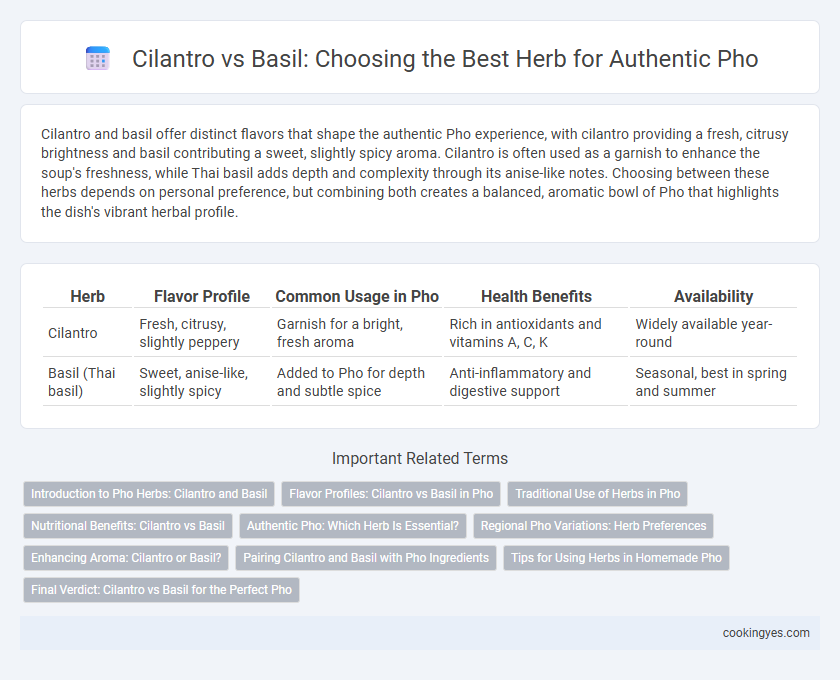Cilantro and basil offer distinct flavors that shape the authentic Pho experience, with cilantro providing a fresh, citrusy brightness and basil contributing a sweet, slightly spicy aroma. Cilantro is often used as a garnish to enhance the soup's freshness, while Thai basil adds depth and complexity through its anise-like notes. Choosing between these herbs depends on personal preference, but combining both creates a balanced, aromatic bowl of Pho that highlights the dish's vibrant herbal profile.
Table of Comparison
| Herb | Flavor Profile | Common Usage in Pho | Health Benefits | Availability |
|---|---|---|---|---|
| Cilantro | Fresh, citrusy, slightly peppery | Garnish for a bright, fresh aroma | Rich in antioxidants and vitamins A, C, K | Widely available year-round |
| Basil (Thai basil) | Sweet, anise-like, slightly spicy | Added to Pho for depth and subtle spice | Anti-inflammatory and digestive support | Seasonal, best in spring and summer |
Introduction to Pho Herbs: Cilantro and Basil
Pho herbs like cilantro and basil each contribute distinct flavors essential to traditional Vietnamese Pho. Cilantro offers a fresh, citrusy brightness that complements the rich broth, while Thai basil provides a slightly spicy, anise-like aroma enhancing the soup's complexity. Selecting the right balance of these herbs elevates the authentic taste experience of Pho.
Flavor Profiles: Cilantro vs Basil in Pho
Cilantro delivers a fresh, citrusy, and slightly peppery flavor that brightens the savory broth of Pho, while Thai basil imparts a sweet, anise-like aroma and a hint of spiciness, adding depth and complexity. The interplay between cilantro's bright notes and basil's warm, aromatic qualities creates a balanced herbal profile essential to traditional Pho. Selecting between cilantro and basil ultimately shapes the overall flavor character, influencing the dish's authenticity and sensory experience.
Traditional Use of Herbs in Pho
In traditional Vietnamese pho, cilantro and Thai basil serve distinct roles, with cilantro primarily added as a fresh garnish to enhance aroma and provide a bright, citrusy note. Thai basil, on the other hand, is often added directly to the hot broth or served on the side to infuse a sweet, anise-like flavor that complements the rich beef or chicken broth. The deliberate use of these herbs reflects regional variations and emphasizes the balance of fresh, herbal flavors essential to authentic pho.
Nutritional Benefits: Cilantro vs Basil
Cilantro in pho offers higher levels of vitamin K, essential for blood clotting and bone health, while basil provides significant amounts of vitamin A, supporting immune function and vision. Both herbs contain antioxidants, but cilantro's unique phytonutrients contribute to detoxification and anti-inflammatory effects. Incorporating either herb enhances pho's nutritional profile by delivering essential vitamins and promoting overall health benefits.
Authentic Pho: Which Herb Is Essential?
Authentic Pho traditionally features Thai basil as the essential herb, providing a distinctive anise-like aroma that complements the rich beef broth. Cilantro, while popular in some regions, is not a traditional ingredient and adds a fresh, citrusy note that can alter the classic flavor profile. For a truly authentic Pho experience, Thai basil remains the indispensable herb that defines the dish's signature taste.
Regional Pho Variations: Herb Preferences
Northern Vietnamese pho tends to favor Thai basil, adding a spicier, anise-like flavor that complements the clear, savory broth, while southern versions prominently feature cilantro for its fresh, citrusy aroma that balances the sweeter, richer broth. Central Vietnam blends both herbs, creating a harmonious balance reflecting the region's culinary diversity. Herb preferences in pho not only highlight regional taste profiles but also influence the overall sensory experience of this iconic Vietnamese dish.
Enhancing Aroma: Cilantro or Basil?
Cilantro offers a fresh, citrusy aroma that brightens the broth and provides a distinctive flavor profile essential to authentic Pho. Basil, particularly Thai basil, imparts a sweet, anise-like fragrance that complements the rich, savory broth with a subtle spiciness. Choosing between cilantro and basil depends on the desired aromatic intensity and traditional flavor balance in Pho.
Pairing Cilantro and Basil with Pho Ingredients
Cilantro enhances pho by adding a fresh, citrusy note that complements the rich, savory beef or chicken broth and tender rice noodles. Basil, particularly Thai basil, brings a sweet, slightly spicy aroma that pairs well with the anise and cinnamon flavors in traditional pho spices. Combining cilantro and basil in pho creates a balanced herbaceous profile, elevating the dish's complexity and freshness.
Tips for Using Herbs in Homemade Pho
Cilantro and basil each contribute distinct flavors to homemade pho, with cilantro offering a fresh, citrusy brightness while Thai basil adds a sweet, anise-like aroma. For authentic pho, add cilantro leaves toward the end of cooking or as a garnish to preserve its vibrant taste, while basil should be torn and added just before serving to release its essential oils without wilting. Balancing these herbs enhances the complexity of pho broth, elevating the overall sensory experience.
Final Verdict: Cilantro vs Basil for the Perfect Pho
Cilantro offers a fresh, citrusy flavor that brightens pho while basil provides a sweet, slightly spicy aroma essential for authentic Vietnamese pho. Balancing both herbs enhances the dish's complexity, but cilantro stands out for its ability to cut through rich broth, making it the preferred choice for many pho enthusiasts. For the perfect pho experience, cilantro's vibrant notes are often favored, with basil serving as a complementary herb to deepen the flavor profile.
Cilantro vs basil for Pho herbs Infographic

 cookingyes.com
cookingyes.com